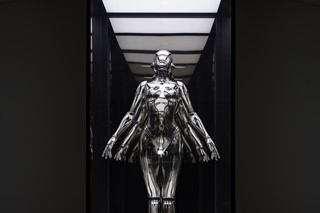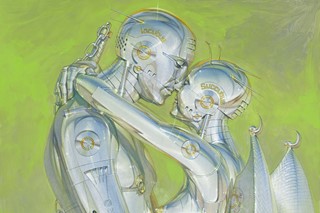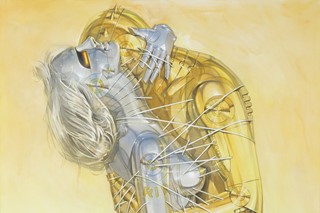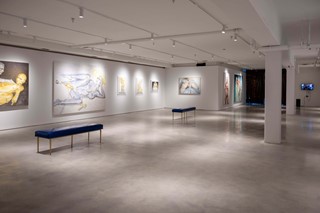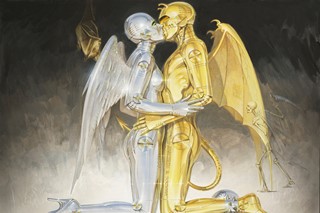NEW YORK (AP) —
Art
Plague as art: Over the centuries, many kinds of stories – Auburn Citizen

This combination of photos shows, from left, “The End of October,” by Lawrence Wright, “The Red Lotus,” by Chris Bohjalian and “Afterland” by Lauren Beukes. Novels coming out now and written before the coronavirus pandemic use plagues to explore everything from gender roles to our own failure to anticipate the worst.
Lauren Beukes, a script and fiction writer, is drawn to narratives that allow her to probe themes of gender and power. For her upcoming novel, “Afterland,” she imagined a plot twist in which a disease wipes out virtually the entire male population.
“I wanted to explore what a world without men would look like and how it wouldn’t necessarily be a better place with everyone making friendship bracelets and growing communal gardens and walking at night,” says Beukes, who began her book years before the current coronavirus pandemic.
Lawrence Wright, the Pulitzer Prize-winning author and journalist, says his new novel was inspired by a question the filmmaker Ridley Scott asked him years ago after reading Cormac McCarthy’s dystopian “The Road”: How could social order break down so completely when we’re struck by sudden disaster? His upcoming thriller “The End of October” describes, uncannily, a global pandemic originating in Asia. He had meant his new book as a cautionary tale.
“Our society has grown blind about dealing with natural hazards because we were so worried about terrorism. Hurricane Harvey caused far more damage than a terrorist attack,” says Wright, known for his nonfiction book “The Looming Tower: Al-Qaeda and the Road to 9/11.”
Plagues have been with us for at least as long as people have been able to record them. But among those who create art, their meaning has changed profoundly according to the time and the teller.
Once regarded as divine punishment, they have served as parables of greed, tyranny and scientific hubris. They have underscored narratives of escapism, vulnerability and save-the-world heroism. They have been treated as catalysts for what we never imagined becoming — and for confirmation of what we were all along.
—For the ancient Greek historian Thucydides, the plague that devastated Athens affirmed his view that prayers were “useless” and his dire belief that laws and codes of honor were easily abandoned.
—Edgar Allan Poe condemned a heartless prince and his foolish belief that he was immune from disease in “The Masque of the Red Death.”
—In Stephen King’s “The Stand,” biowarfare and a careless military are central villains.
—Stephen Soderbergh rejected any political interpretation of his film “Contagion,” saying that the virus in it “was just a virus.” Yet he told The Guardian in 2011 that he did want to “convey the feeling” he sensed worldwide “that the fabric of society really is stretched thin.”
In some eras, little imagination was needed to picture the worst — and hope for the best. Tony Kushner’s epic play “Angels in America” was a defining chronicle of the wreckage of AIDS. The Black Plague of the Middle Ages inspired both terrifying art of ravaged bodies and dancing skeletons and images of Saint Sebastian and Saint Roch intended to console.
“Saint Sebastian had survived being shot with arrows, and Saint Roch was believed to have survived an episode of the plague, so you often see them appearing in art,” says C. Griffith Mann, who curates the Department of Medieval Art at the Metropolitan Museum of Art.
A classic work of literature from the Middle Ages, Bocaccio’s “The Decameron,” reads in some ways as a guide to social distancing and self-isolation. Seven young women and three young men escape from the plague in Florence and live together in a villa, where they entertain each other by telling stories.
“I think Boccaccio anticipated what we would/could do in the time of the plague: We need to escape from our ‘real’ world in which our misery has no explicable cause, no identifiable beginning, and no end in sight,” says Wayne A. Rebhorn, who chairs the English department at the University of Texas at Austin.
“Many of the stories include stories within them — stories used by characters to get out of jams, persuade others to do their bidding, and, at the simplest level, entertain those who read or listen to them. If the plague shows just how desperate and fragile human life can be, stories offer a way to cope with that desperation.”
Plague books can be a way of tracking other changes in society. The 1665 plague in London was the basis for Daniel Defoe’s “A Journal of the Plague Year,” which was published decades later and was noted for its detailed account of the city’s ordeal. Defoe scholar and Auburn University professor Paula Backscheider notes that his book came out at a time when the Renaissance had challenged religious beliefs, and that for the author the London plague was a way of looking beyond religious reasons for human suffering.
“He is grippingly driven to try to decide if the plague is the will of God,” Backscheider says, “or if there are scientific explanations that would explain how it started and spread, how people could protect themselves from it, and how it might be treated humanely and effectively.”
In the 20th century, Albert Camus’ “The Plague” was widely seen as a parable for the Nazi occupation of France and the eventual liberation — and as a statement on the randomness of fate. Katherine Anne Porter’s “Pale Horse, Pale Rider” was inspired by the flu epidemic of 1918-1919 that killed millions at the same time that World War I, which killed millions more, was ending. She published the short novel in 1939, as a new world war began.
“Her illness is grounded in a real influenza pandemic, but because her illness is associated with the war (it ends with the Armistice), it symbolizes the spiritual malaise of the 20th century,” says Dorothy Unrue, a Porter scholar who edited a volume of her work for the Library of America.
Chris Bohjalian’s new novel, “The Red Lotus,” has just been published. The author looks for stories about “heartbreak and dread” and thought of a pandemic — an idea he developed after reading an article about mice carrying viruses resistant to treatment. In his book, rats are the carriers of diseases, although people are the real villains.
“I don’t view the possible pandemic in the novel as a metaphor,” he says. “(But) a pathogen doesn’t attack a human with conscious malice. But humans? We are all too conscious of the carnage we can inflict on one another.”
Follow AP National Writer Hillel Italie on Twitter at @hitalie.
Copyright 2020 The Associated Press. All rights reserved. This material may not be published, broadcast, rewritten or redistributed without permission.
Art
The unmissable events taking place during London's Digital Art Week – Euronews
From W1 Curates’ immersive digital projections to HOFA Gallery’s curated AI artwork showcase, don’t miss out on these stunning events during London’s Digital Art Week.
Digital Art Week is here!
Throughout the week, Londoners will have the opportunity to immerse themselves in digital art across the capital, from prestigious galleries to outdoor spaces, iconic music venues, and over 100 digital billboards.
A multitude of outdoor billboard locations, including Piccadilly Circus, will be transformed for the event, bringing digital art into the public eye and making it accessible to all. In total, works from over 120 leading artists will be showcased.
“We are thrilled to be back in London for Digital Art Week. This year will be the biggest iteration of the movement that we have ever produced. This year we are using the fabric of the city to showcase more than 120 artists across a wide variety of venues and artistic mediums,” says Digital Art Week CEO and founder Shaina Silva.
With so much happening, here’s a simple guide to some of the events you won’t want to miss:
‘New Beginnings’ at HOFA Gallery
When? – Thursday, 25 April, 6pm-9pm.
Where? – HOFA Gallery, 11 Bruton Street, London, W1J 6PY.
London’s HOFA Gallery, situated on Bruton Street, has curated an exceptional exhibition titled ‘New Beginnings,’ showcasing artists who are at the forefront of integrating artificial intelligence into their creative processes.
Among the featured artists in their showcase, titled ‘New Beginnings’, is Niceaunties, a Singapore-based architect and AI artist who draws inspiration from her cultural heritage to explore themes of aging, personal freedom, and everyday life through generative AI and digital art.
Also included is Sougwen 愫君 Chung, a Chinese-Canadian artist whose piece “MEMORY (Drawing Operations Unit: Generation 2)” made history as the first AI model acquired by London’s V&A museum, as well as digital artist, Agoria, known for his avant-garde BioGenArt.
W1 Curates immersive galleries
When? – During the whole of Digital Art Week.
Where? – 167 Oxford Street, London, W1D 2JP.
W1 Curates, a public art platform situated in the heart of London’s iconic Oxford Street, is hosting a series of free cutting-edge events during Digital Art Week.
These events will feature some of the world’s leading digital artists, including Beeple and Andrés Reisinger.
Here’s the schedule:
Six N Five – Tuesday, 23 April, 8pm-9pm.
GMUNK – Thursday, 25 April 8pm-9pm.
Lost Souls of Saturn – Friday, 26 April, 8pm-9pm.
Ash Thorpe – Friday, 26 April, 8pm-9pm.
Beeple – Saturday, 27 April, 8pm-9pm.
Andrés Reisinger – Sunday, 28th April, 8pm-9pm.
Krista Kim presented on Outernet’s four storey LED screen
When? – Friday, 26 April, 9am till late.
Where? – Charing Cross Rd, London, WC2H 8LH.
TAEX is presenting Canadian-Korean contemporary artist Krista Kim’s “Continuum” collection, an awe-inspiring visual meditation that will be showcased on Outernet’s four-storey LED screen.
Kim’s Rothko-inspired artwork, created from LED light photography and cutting-edge software, offers vibrant colourscapes that aim to elevate consciousness and inspire positivity in the digital realm.
Also, you can look forward to the soothing sounds of electronic group Ligovskoï, whose healing frequency music complements Kim’s mesmerising visuals.
But Kim isn’t the only artist on display at Outernet. You can also catch AMIANGELIKA / Ouchhh (23 April), Zach Lieberman (24 April), Jesse Woolston (25 April), and Sasha Stile (27 April).
‘Daata’ at Shoreditch Arts Club
When? – Thursday, 25 April, 7pm-11pm
Where? – Shoreditch Arts Club, 6 Redchurch Street, London.
If you enjoy cocktails, reggae music and trippy, surreal digital animations then this could be the event for you.
Shoreditch Arts Club, in collaboration with their long-time moving image partner Daata, is hosting a party to celebrate Digital Art Week. Visitors can expect to experience mesmerising digital artworks on screens, accompanied by the legendary sounds of reggae DJ Manasseh.
The evening will showcase The Rockers Uptown – The Shoreditch Version, a curated playlist of commissioned video animations handpicked by Daata’s founder David Gryn. Featuring works by esteemed artists such as George Barber, Phillip Birch, and many more, this event promises to be an immersive journey into a surreal world of digital art.
Art
Random: We're In Awe of Metaphor: ReFantazio's Box Art – Push Square
There’s nothing quite like video game box art that makes you stop and say “wow”. Admittedly, it’s been a while since such a cover caught our eye, but we simply can’t gawk at the newly revealed box art for Metaphor: ReFantazio and not write an article about it.
The upcoming RPG looks to be a stunner in terms of art direction, and the cover gives you a taste of that before you even get started. It features gorgeous character-focused art, and although we still think the name ‘Metaphor: ReFantazio’ is a bit… overwrought, we can’t argue with the logo, which is striking.
NieR: Automata’s Kazuma Koda is credited as Metaphor’s concept artist, so we’re assuming it’s his work that’s decorating this box, but it’s also worth noting that longtime Persona character designer Shigenori Soejima is running the show.

Are you as taken with Metaphor’s box art as we are? Have a quick say in our poll and then make some room on your shelf in the comments section below.
Art
Hajime Sorayama on the erotic aesthetics of his sexy robot art
|
|


We speak to the controversial Japanese artist about fetishism, his never-before displayed ‘hardcore’ paintings and Desire Machines – one of the inaugural exhibitions at the Museum of Sex opening soon in Miami



Hajime Sorayama, Untitled (2020) Acrylic on illustration board H51.5 x W72.8 cm©Hajime Sorayama Courtesy of NANZUKA

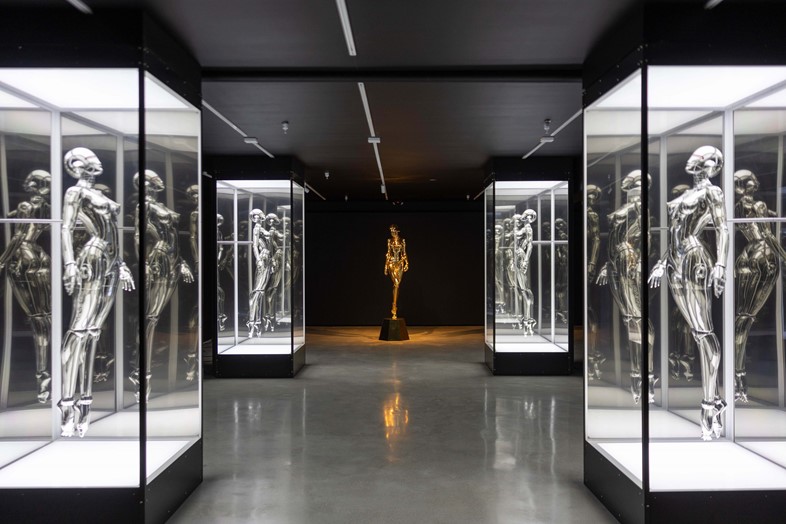

Hajime Sorayama installation shot, Museum of Sex Miami (2024)©Hajime Sorayama Courtesy of NANZUKA
,
“articleBody”: “Shoyer adds: “I appreciate how Sorayama’s work engenders discussions about the real and the fantastic, the erotic appeal of the inorganic, and the porous boundaries between being human, machine, and animal, especially in relation to subjectivity or myths of consent.” She says there’s one particular piece she wants to highlight – and one that ties the Museum of Sex Miami’s inaugural programme together nicely. “The painting [an untitled work painted by Sorayama in 2022] features a fembot using a vibrator,” she explains. “Gold halos hover over the robot’s head and the head of the vibrator, sanctifying both machines. The vibrator features a hand crank, referencing the early history of vibrators – a history that’s also on view in Modern Sex. Hand-cranked vibrating stimulatory machines were first invented during the industrial revolution. An object like the Vee Dee vibrator (1900-1915) features a similar hand-crank to the vibrator on view in Sorayama’s painting. As such, in this work, Sorayama seems to combine the early history of mechanical stimulators with a futuristic look at self-stimulation. Here, the past, present, and our visions for the future compound. The painting seems to ask, ‘How has erotic desire, self-stimulation, and the subjectivity of other-than-human figures manifested, and how will it play out going forward?’.”
By referencing the past in this way (see also his Marilyn Monroe android pin-up), Sorayama imbues his ‘sexy robots’ – who he refers to as his wives and daughters – with a past. They’re simultaneously human, with realistic, supple flesh and familiar histories, and yet disorientingly non-human, futuristic, and fantastical. At a time when we have more tools than ever than envision a different kind of eroticism – and yet people use AI to reinforce the same Western ideals of sexiness – Sorayama remains one of the few still really pushing the boundaries of what eroticism can look like. “I’m excited and very proud of how [Desire Machines] came together,” he concludes. “I can’t wait to see the viewers’ reaction. I just need to keep behaving myself so I won’t get arrested before the show starts.”
Visit the gallery above for a closer look at some of the artwork going on display at the Musuem of Sex in Miami.
Museum of Sex Miami opens in 2024. Follow their Instagram for updates.”,
“mainEntityOfPage”: “https://www.dazeddigital.com/art-photography/article/62457/1/hajime-sorayama-museum-sex-miami-erotic-sex-robots-exhibition-xxx-hardcore”,





-



 Health8 hours ago
Health8 hours agoRemnants of bird flu virus found in pasteurized milk, FDA says
-
Art14 hours ago
Mayor's youth advisory council seeks submissions for art gala – SooToday
-



 Science22 hours ago
Science22 hours ago"Hi, It's Me": NASA's Voyager 1 Phones Home From 15 Billion Miles Away – NDTV
-
News20 hours ago
Some Canadians will be digging out of 25+ cm of snow by Friday – The Weather Network
-



 Health12 hours ago
Health12 hours agoBird flu virus found in grocery milk as officials say supply still safe
-
Media19 hours ago
Jon Stewart Slams the Media for Coverage of Trump Trial – The New York Times
-



 Sports23 hours ago
Sports23 hours agoAuston Matthews turns it up with three-point night as Maple Leafs slay Bruins in Game 2 – Toronto Sun
-



 Investment13 hours ago
Investment13 hours agoTaxes should not wag the tail of the investment dog, but that’s what Trudeau wants






